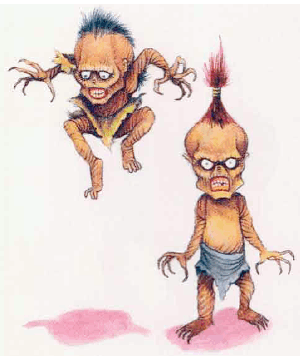

2501

| Climate/Terrain: | Tropical or subtropical jungles, ruins, subterranean |
|---|---|
| Frequency: | Very rare |
| Organization: | Group |
| Activity Cycle: | Any |
| Diet: | None |
| Intelligence: | Semi- (2-4) |
| Treasure: | Nil |
| Alignment: | Chaotic evil |
| No. Appearing: | 2d4 |
| Armor Class: | 6 |
| Movement: | 12 |
| Hit Dice: | 3 |
| THAC0: | 17 |
| No. of Attacks: | 2 |
| Damage/Attack: | 1d6 (claw)/1d6 (claw) |
| Special Attacks: | Poison, leap |
| Special Defenses: | Immune to some spells |
| Magic Resistance: | Nil |
| Size: | T (2’ tall) |
| Morale: | Average (10) or fearless (20) |
| XP Value: | 270 |
Topis are tiny undead humanoid creatures similar to zombies. Before these creatures are animated, however, the corpses are shrunk until they are only 2 feet tall. The process gives them dark, wrinkled, leathery skin Their eves are wide and bulging, and their lips are usually curled back, freezing their faces into permanent toothy grimaces (occasionally, however, the lips are sewn shut.
Like zombies, topis usually are clad in the tattered remains of whatever clothing they were wearing when they died. Unlike zombies, topis do not have a rotting stench, as the shrinking process also preserves their flesh.
Topis cannot speak but often hiss, snarl, grunt, or gnash their teeth when attacking.
Combat: Topis are much more agile than normal zombies, and they roll for initiative in the usual manner. They can leap up to 6 feet in combat, vertically or horizontally.
Topis are intelligent and can follow fairly complex instructions. If left to their own devices, they try to use their leaping ability to disorient their foes. Their favorite tactics include surrounding foes by leaping upward onto roofs or overhanging branches, than dropping back down to attack from behind.
Like most undead, topis are immune to sleep, charm, and hold spells, death magic, poisons, and cold-based attacks. They can be turned as wights. A vial of holy water infiicts 2d4 points of damage when it strikes a topi.
Blunt weapons inflict only half-damage on a topi, but if the wielder is human-sized (size M) or larger the topi is knocked off balance and loses any attacks or unfinished actions during the remainder of the round. In addition, the topi suffers a +5 penalty to its initiative roll for the next round.
A topi’s claws carry a debilitative venom. Creatures struck by a claw must roll a saving throw vs. poison. If the saving throw fails, the victim suffers a general unease and slowing of the metabolism which begins the next round and lasts for 1d2 turns. A slow poison spell, applied in the round of the injury or the first round of the effect, delays the venom’s effects for the duration of the spell; slow poison applied later is ineffective. A neutralize poison or heal spell, or Keoghiom’s ointment, curtails the venom’s effects.
The effect of the poison is similar to that of a slow spell. The victim moves and attacks at half the normal rate. He or she also suffers a +4 penalty to Armor Class, an attack penalty of -4, an initiative penalty of +2, and the loss of all combat bonuses due to Dexterity. Note that this is a nonmagical effect and as such cannot be negated by items such as a ring of free action.
Once ordered into combat, a topi never checks morale. It attacks until it is destroyed, or ordered to retreat by the spellcaster who animated it.
Habitat/Society: Like zombies, topis exist only to serve the spellcaster who animated them. Their intelligence and evil nature make them prone to malice, however, and it is unwise to trust them with anythmg delicate or overly complex.
Topis are usually found guarding tribal burial grounds or temples. Some witch doctors and shamans also employ them as servants, scouts, and bodyguards.
Ecology: Topis are unnatural creatures who have no ecological role except as a consequence of their orders. They can, for example, be ordered to gather food or hunt small game. Unless ordered otherwise, a topi left on its own will gleefully maim and kill anything it can catch. Topis do not require food or water, killing only for pleasure or to obey orders.
The dead body of any humanoid creature can be made into a topi. Only a few tribal spell casters know bow to shrink the corpses, however. The few travelers who have observed the process and have been lucky enough to return to tell the tale report that the corpse is boiled for several days in a mixture of water, herbs, and animal organs, then dried in the sun and animated, presumably with a variant animate dead spell.

◆ 1842 ◆